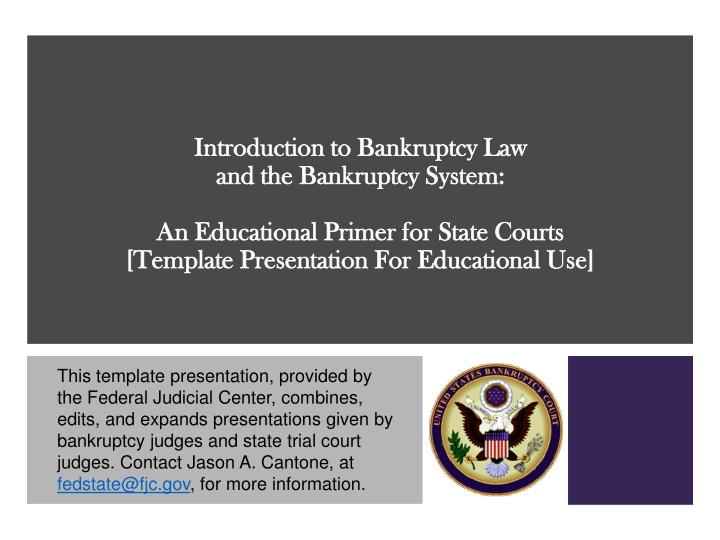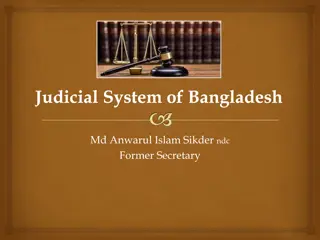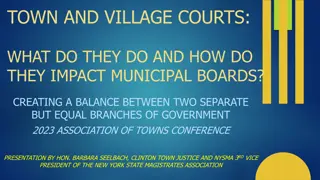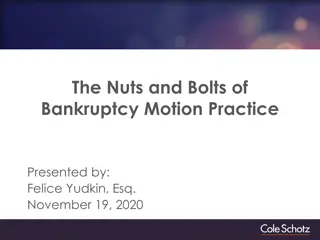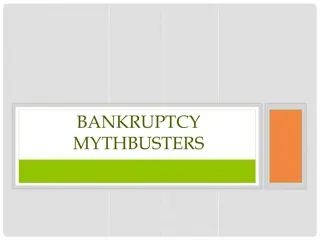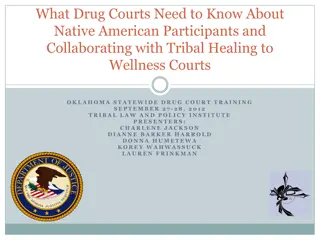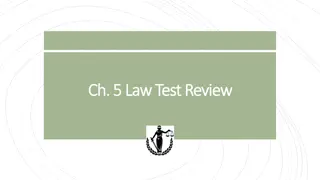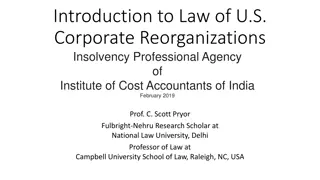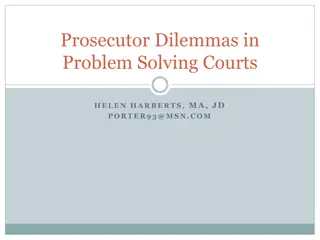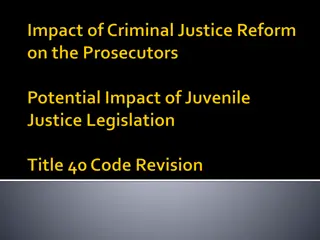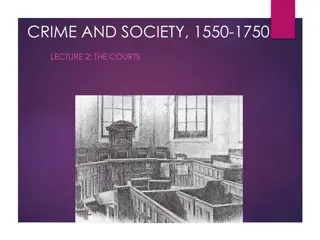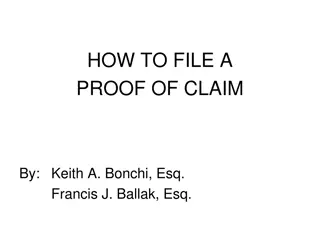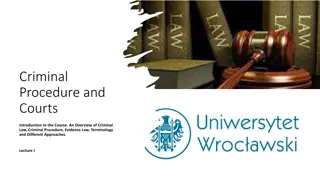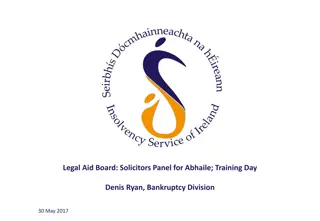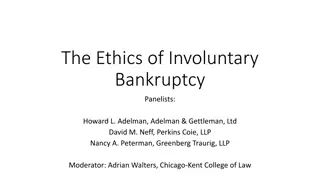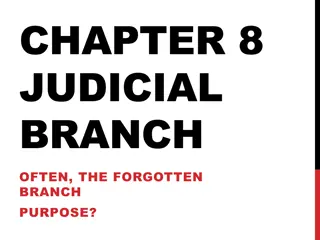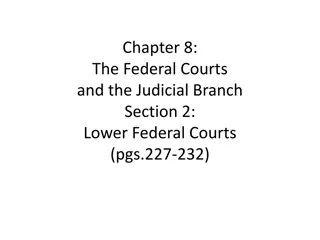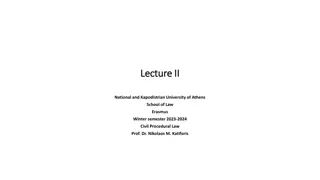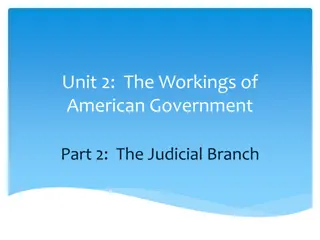Bankruptcy Law Overview for State Courts
This educational primer provides an overview of bankruptcy law, including the bankruptcy system, key concepts, and what state court judges can do when dealing with bankruptcy cases. It covers topics such as equality of distribution, fresh start for debtors, bankruptcy policies, and the role of state courts in bankruptcy proceedings.
Download Presentation

Please find below an Image/Link to download the presentation.
The content on the website is provided AS IS for your information and personal use only. It may not be sold, licensed, or shared on other websites without obtaining consent from the author.If you encounter any issues during the download, it is possible that the publisher has removed the file from their server.
You are allowed to download the files provided on this website for personal or commercial use, subject to the condition that they are used lawfully. All files are the property of their respective owners.
The content on the website is provided AS IS for your information and personal use only. It may not be sold, licensed, or shared on other websites without obtaining consent from the author.
E N D
Presentation Transcript
Introduction to Bankruptcy Law Introduction to Bankruptcy Law and the Bankruptcy System: and the Bankruptcy System: An Educational Primer for State Courts An Educational Primer for State Courts [Template Presentation For Educational Use] [Template Presentation For Educational Use] This template presentation, provided by the Federal Judicial Center, combines, edits, and expands presentations given by bankruptcy judges and state trial court judges. Contact Jason A. Cantone, at fedstate@fjc.gov, for more information.
Content Note This presentation only provides the bankruptcy overview. A full presentation with all six topics (bankruptcy overview; automatic stay; bankruptcy discharge; family law; foreclosure; additional considerations) is available at fjc.gov/fedstate, as well as separate presentations for each of those topics.
Someone tells you they filed bankruptcy. What could a state court judge do? Ask Ask for the bankruptcy case number and where the debtor filed it. Consider Continue Call Call Consider whether the state proceeding would violate the stay. If you think the stay applies, continue the proceeding until you have confirmation there is relief from the stay or the stay was dissolved. Call the bankruptcy clerk s office to ask whether the debtor filed a petition and whether relief from the automatic stay was granted. Call a bankruptcy judge (or his/her law clerk) Many bankruptcy judges would welcome calls from state court judges!
The Twin Pillars of Bankruptcy equality of distribution of available assets among similarly situated creditors fresh start for honest but unfortunate debtors
Bankruptcy Policies Equality of distribution Priority given to creditors holding certain types of debt. Pro rata distribution for similarly situated creditors preventing a race to the courthouse. Important factors: context of reorganization, adjustment of debt and repayment plan, and liquidation. Fresh start Automatic stay freezes collection activity to give debtor a breathing spell. Discharge releases debtor from personal liability for certain specified types of debt; a permanent injunction on collection. Federal and state laws allow debtors to keep certain assets (exempt property).
Bankruptcy Policies Maximizing value of assets and distributions Obtain best possible price for assets, financing, and new equity to maximize recovery for creditors. Reorganizing and rehabilitating businesses can preserve jobs.
Who are the parties? Debtor: Individual or organization that has voluntarily filed a bankruptcy petition or, in rare cases, is the subject of an involuntary bankruptcy commenced by creditors. Debtor-in-possession: Debtor in a case that maintains possession and control of its assets (i.e., existing management remains in place) in bankruptcy. Trustee: Representative of the bankruptcy estate who exercises statutory powers, principally for the benefit of unsecured creditors. Trustee is always appointed or elected in Chapters 7, 12, 13; sometimes in Chapter 11; never in Chapter 9. Creditors: Individuals or organizations to which the debtor owes money or that claim to be owed money by the debtor.
Who are the parties? Examiner: Independent functionary appointed to conduct an investigation of the debtor s affairs in a Chapter 11 case in which existing management remains in place and no case trustee is appointed Bankruptcy Administrator: Oversees the administration of bankruptcy cases, maintains a panel of private trustees, and monitors the transactions and conduct of parties (North Carolina and Alabama, Established in 1986) U.S. Trustee: Officer of the Department of Justice responsible for supervising administration of bankruptcy cases A watch dog over the bankruptcy process; different from trustee
Who are the parties? Creditors Committee: A committee of creditors appointed by the U.S. Trustee in Chapter 11 cases and ordinarily consisting of unsecured creditors holding the largest unsecured claims against the debtor; consults with debtor-in-possession on administration of the case; investigates the debtor s conduct and operation of the business; participates in formulating a plan of reorganization. Creditors committees may also be formed for other claimant groups such as secured creditors, bondholders, and retirees.
DEBTOR(S) DESCRIPTION Business or Individual 7 Provides for liquidation or sale of the debtor s nonexempt property and the distribution of proceeds to creditors. Liquidation is administered by a trustee. Provides for the restructuring of a municipality s debts. Municipality 9 Bankruptcy Law 101: Chapters Business or individual 11 Provides for reorganization, usually of a corporation or partnership; a Chapter 11 debtor usually proposes a plan of reorganization to keep its business alive and to pay creditors over time; people in business and individuals can also seek relief under Chapter 11. Court holds a confirmation hearing and at least one class of impaired creditors must support the plan. Business or individual 12 Provides for adjustment of debts of a family farmer or family fisherman. Provides for adjustment of debts of an individual with regular income; a Chapter 13 debtor is usually allowed to keep property and pay debts over time. Individual 13 Provides for cooperation in ancillary and other cross-border cases. Business (outside of U.S.) 15
Questions to consider Is the bankruptcy a Chapter 7, 11, 12, or 13? Who is the actual debtor in the bankruptcy? (Individual, married couple, other?) Who is the proper party to a lawsuit in which the debtor is a party? (Chapter 7 trustee, debtor-in-possession under Sections 323, 1303, 1203, or 1107, emerging debtor, court-appointed trustee?) Is substitution necessary? (Typically, only in a Chapter 7 case.) Is the debt a Domestic Support Obligation (DSO)?
Questions to consider Does the automatic stay apply? If so, has the court granted relief from the stay? Has the exempt property been determined? Is the debt dischargeable or has the debt been discharged? Have any payments been made to the Chapter 13 trustee on account of past-due support obligations?
Chapter 9 bankruptcy will not be discussed in this presentation. For more information on Chapter 9, see: The Chapter 9 Process Navigating Chapter 9 of the Bankruptcy Code (a 2017 publication coordinated by the Federal Judicial Center (FJC)) Chapter 9 Online Resource Repository (an FJC resource with examples of case documents and other resource materials related to issues likely to arise in Chapter 9 cases)
Petition, schedules, and statement of financial affairs filed inception of automatic stay creation of the estate appointment of trustee notice to creditors of case commencement, meeting of creditors, and discharge and claims objections The Chapter 7 Process Meeting of creditors ( 341 meeting ) Issuance of Discharge Liquidation of Nonexempt Assets, if any (prevalence of no asset cases) Closing of case Note: The majority of cases are over in about 120 days
As a result of passage of the Small Business Reorganization Act (which went into effect February 19, 2020), there is a new Subchapter V to Chapter 11, with a number of unique provisions for small business debtors. Chapter 11, Subchapter V Advice: For those involved in cases with small business debtors, reviewing this new subchapter is important.
Chapter 13 is another means for individual debtors to get a discharge of their debts. Chapter 13 Process Requires a debtor to formulate a repayment plan and to schedule payments to creditors of their disposable income over a three-to-five-year period.
Once the Chapter 13 plan is finalized and negotiated with the debtor s creditors and the Chapter 13 trustee, the court will enter a confirmation order approving the plan. Chapter 13 Process Only when the Chapter 13 debtor finishes making all of the payments due under the plan does the debtor get an order of discharge.
Caution: Chapter 13 changes the definition of property of the estate to include property acquired postpetition. See 11 U.S.C. 1306(a)(1). Chapter 13 Process
Petition, schedules, and statement of financial affairs filed inception of automatic stay creation of the estate, but debtor remains in possession appointment of trustee notice to creditors of case commencement, meeting of creditors, and discharge and claims objections Chapter 13 Process Filing of plan Meeting of creditors ( 341 meeting ) Plan confirmation and performance over up to five years (trustee s role) Discharge issued when plan payments are complete
Why file under Chapter 13? Means test and abuse standards compel some debtors to file under Chapter 13 (rather than Chapter 7) Chapter 13 debtors can cure defaulted secured debts over plan term Chapter 13 debtors can pay delinquent taxes over five years with no postpetition interest Chapter 13 debtors get a slightly broader discharge
Property of the Estate All legal and equitable interests of the debtor in property as of the date of the bankruptcy commencement. Includes legal claims by the debtor (including tort claims and lawsuits) against others, even if disputed or unliquidated. Does not include: property in which the debtor holds only legal title but no equitable interest beneficial interests in spendthrift trusts funds held in certain retirement and education savings accounts
Property of the Estate The Bankruptcy Court has exclusive jurisdiction over property of the estate. Individual debtors can exempt certain property from the estate, making it unreachable by unsecured creditors.
Property of the Estate Income from personal services rendered after petition date: not included in Chapter 7 estate included in Chapters 11, 12, and 13 estates Property leaves the estate by: sale (or other disposition) by trustee or debtor timely and valid claim of exemption by debtor abandonment (if the trustee decides the value is not worth administering in bankruptcy)
Civil actions related to a bankruptcy case may be removed to federal court on the basis of bankruptcy jurisdiction. Removal is automatic upon the filing of a notice of removal with the appropriate court clerk. Removal and Remand The bankruptcy court may remand an action back to court from which it was removed upon the filing of a timely motion and on any equitable ground. An order granting or denying remand is not subject to appellate review.
Advice: When considering removal, remand, or bankruptcy court abstention in favor of a pending state court action, the bankruptcy court considers the status and projected date-to-outcome of a pending state court action if it were to continue in the state court. Removal and Remand
Lower federal courts, including the bankruptcy courts, may not review the decisions of state courts. Where bankruptcy and state courts have concurrent jurisdiction, the Rooker Feldman doctrine prevents a collateral attack upon a state court s decision concerning federal law even when that decision is clearly erroneous. The Rooker Feldman Doctrine Such a decision may be reviewed only through the appellate process.
Additional Resources Federal Judicial Center website on federal- state cooperation: https://fjc.gov/fedstate National Center for State Courts resource guide on foreclosures: https://www.ncsc.org/Topics/Financial/Foreclos ures/Resource-Guide.aspx
This presentation was organized by Federal Judicial Center Senior Research Associate Jason A. Cantone, with considerable assistance by a number of federal and state judges and court personnel (see note for slide 1). Thank You Questions about the presentation and its use can be directed to Dr. Cantone, at fedstate@fjc.gov. We would also like to hear from you if you find it helpful or have any recommendations to improve it.
